Isfahan
| Isfahan اصفهان | ||
|---|---|---|
| city | ||
| Ancient names: Spahān, Aspadana | ||
 | ||
| ||
| Nickname(s): Nesf-e Jahān (Half of the world) | ||
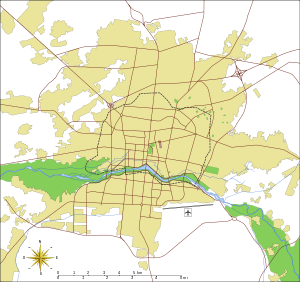 Isfahan | ||
 Isfahan Isfahan in Iran | ||
| Coordinates: 32°38′N 51°39′E / 32.633°N 51.650°ECoordinates: 32°38′N 51°39′E / 32.633°N 51.650°E | ||
| Country | Iran | |
| Province | Isfahan | |
| County | Isfahan | |
| District | Central | |
| Government | ||
| • Governor General | Rasul Zargar | |
| • Mayor | Mehdi Jamali Nejad | |
| Area[1] | ||
| • Urban | 493.82 km2 (190.66 sq mi) | |
| Elevation | 1,574 m (5,217 ft) | |
| Population (2011 census) | ||
| • city | 1,756,126 | |
| • Population Rank in Iran | 3rd | |
| Population Data from 2011 Census[2] | ||
| Time zone | IRST (UTC+3:30) | |
| • Summer (DST) | IRDT 21 March – 20 September (UTC+4:30) | |
| Website | www.isfahan.ir | |
Isfahan (Persian: اصفهان, ![]() pronunciation ), also Romanized as Esfahān historically also rendered in English as Ispahan, Sepahan, Esfahan or Hispahan, is the capital of Isfahan Province in Iran, located about 340 kilometres (211 miles) south of Tehran. At the 2011 census, it had a population of 1,756,126 and its built-up (or metro) area was home to 2,391,738 inhabitants including Khomeynishahr, Shahinshahr, Khvorasgan, Dorcheh Piaz, Falavarjan, Kelishad Va Sudarjan, Abrisham, Kushk and Kharizsang cities.[2] The Greater Isfahan Region had a population of 3,793,104 in the 2011 Census, the third most populous metropolitan area in Iran after Tehran and Mashhad.[3] The counties of Isfahan, Borkhar, Najafabad, Khomeynishahr, Shahinshahr, Mobarakeh, Falavarjan, Tiran o Karvan and Lenjan all constitute the metropolitan city of Isfahan.
pronunciation ), also Romanized as Esfahān historically also rendered in English as Ispahan, Sepahan, Esfahan or Hispahan, is the capital of Isfahan Province in Iran, located about 340 kilometres (211 miles) south of Tehran. At the 2011 census, it had a population of 1,756,126 and its built-up (or metro) area was home to 2,391,738 inhabitants including Khomeynishahr, Shahinshahr, Khvorasgan, Dorcheh Piaz, Falavarjan, Kelishad Va Sudarjan, Abrisham, Kushk and Kharizsang cities.[2] The Greater Isfahan Region had a population of 3,793,104 in the 2011 Census, the third most populous metropolitan area in Iran after Tehran and Mashhad.[3] The counties of Isfahan, Borkhar, Najafabad, Khomeynishahr, Shahinshahr, Mobarakeh, Falavarjan, Tiran o Karvan and Lenjan all constitute the metropolitan city of Isfahan.
Isfahan is located on the main north–south and east–west routes crossing Iran, and was once one of the largest cities in the world. It flourished from 1050 to 1722, particularly in the 16th century under the Safavid dynasty, when it became the capital of Persia for the second time in its history. Even today, the city retains much of its past glory. It is famous for its Persian–Islamic architecture, with many beautiful boulevards, covered bridges, palaces, mosques, and minarets. This led to the Persian proverb "Esfahān nesf-e- jahān ast" (Isfahan is half of the world).[4]
The Naghsh-e Jahan Square in Isfahan is one of the largest city squares in the world and an outstanding example of Iranian and Islamic architecture. It has been designated by UNESCO as a World Heritage Site. The city also has a wide variety of historic monuments and is known for the paintings, history and architecture.
History
Name
The name of the region derives from Middle Persian Spahān. Spahān is attested in various Middle Persian seals and inscriptions, including that of Zoroastrian Magi Kartir.[5] The present-day name is the Arabicized form of Ispahan (unlike Middle Persian, New Persian does not allow initial consonant clusters such as sp[6]). The region appears with the abbreviation GD (Gay, Southern Media) on Sasanian numismatics. In Ptolemy's Geographia it appears as Aspadana, translating to "place of gathering for the army". It is believed that Spahān derives from spādānām 'the armies', Old Persian plural of spāda (from which derives spāh 'army' in Middle Persian).
Prehistory
The history of Isfahan can be traced back to the Palaeolithic period. In recent discoveries, archaeologists have found artifacts dating back to the Palaeolithic, Mesolithic, Neolithic, Bronze and Iron ages.
Pre-Islamic era




It is noteworthy to say that what was to become the city of Isfahan in later historical periods probably emerged as a locality and settlement that gradually developed over the course of the Elamite civilization (2700–1600 BCE).
During the Median dynasty, this commercial entrepôt began to show signs of a more sedentary urbanism, steadily growing into a noteworthy regional centre that benefited from the exceptionally fertile soil on the banks of the Zayandehrud River in a region called Aspandana or Ispandana.
Once Cyrus the Great (reg. 559–529 BCE) unified Persian and Median lands into the Achaemenid Empire (648–330 BCE), the religiously and ethnically diverse city of Isfahan became an early example of the king's fabled religious tolerance. It is said that after Cyrus the Great freed the Jews from Babylon some Jews returned to Jerusalem whereas some others decided to live in Persia and settle in what is now known as Isfahan. But, actually this happened later in the Sasanid period when a Jewish colony was made in the vicinity of the Sasanid Gay.[7]
The tenth century Persian historian Ibn al-Faqih al-Hamedani wrote:
"When the Jews emigrated from Jerusalem, fleeing from Nebuchadnezzar, they carried with them a sample of the water and soil of Jerusalem. They did not settle down anywhere or in any city without examining the water and the soil of each place. They did all along until they reached the city of Isfahan. There they rested, examined the water and soil and found that both resembled Jerusalem. Upon they settled there, cultivated the soil, raised children and grandchildren, and today the name of this settlement is Yahudia."[8]
The Parthians (250 BCE – 226 CE) continued the tradition of tolerance after the fall of the Achaemenids, fostering the Hellenistic dimension within Iranian culture and political organization introduced by Alexander the Great's invading armies. Under the Parthians, Arsacid governors administered a large province from Isfahan, and the city's urban development accelerated to accommodate the needs of a capital city.
The next empire to rule Persia, the Sassanids (226 – 652 CE), presided over massive changes in their realm, instituting sweeping agricultural reform and reviving Iranian culture and the Zoroastrian religion. The city was then called by the name Gay and the region by the name Aspahan or Spahan. The city was governed by "Espoohrans" or the members of seven noble Iranian families who had important royal positions, and served as the residence of these noble families as well. Extant foundations of some Sassanid-era bridges in Isfahan suggest that the kings were also fond of ambitious urban planning projects. While Isfahan's political importance declined during the period, many Sasanian princes would study statecraft in the city, and its military role developed rapidly. Its strategic location at the intersection of the ancient roads to Susa and Persepolis made it an ideal candidate to house a standing army, ready to march against Constantinople at any moment. The words 'Aspahan' and 'Spahan' are derived from the Pahlavi or Middle Persian meaning 'the place of the army'.[9] Although many theories have been mentioned about the origin of Isfahan, in fact little is known of Isfahan before the rule of the Sasanian dynasty (c. 224–c. 651 CE). The historical facts suggest that in the late 4th and early 5th centuries Queen Shushandukht, the Jewish consort of Yazdegerd I (reigned 399–420) settled a colony of Jews in Yahudiyyeh (also spelled Yahudiya), a settlement 3 kilometres northwest of the Zoroastrian city of Gay (the Achaemid and Parthian 'Gabae' or 'Gabai', the Sasanid 'Gay' and the Arabicized form 'Jay') that was located just on the northern bank of the Zayanderud River. The gradual population decrease of Gay or Jay and the simultaneous population increase of Yahudiyyeh and its suburbs after the Islamic conquest of Iran resulted in the formation of the nucleus of what was to become the city of Isfahan. It should be noted that the words Aspadana, Ispadana, Spahan and Sepahan from which the word Isfahan is derived all referred to the region in which the city was located.
Islamic era
When the Arabs captured Isfahan in 642, they made it the capital of al-Jibal (“the Mountains”) province, an area that covered much of ancient Media. Isfahan grew prosperous under the Persian Buyid (Buwayhid) dynasty, which rose to power and ruled much of Iran when the temporal authority of the Abbasid caliphs waned in the 10th century. The Turkish conqueror and founder of the Seljuq dynasty, Toghril Beg, made Isfahan the capital of his domains in the mid-11th century; but it was under his grandson Malik-Shah I (r. 1073–92) that the city grew in size and splendour.[10]
After the fall of the Seljuqs (c. 1200), Isfahan temporarily declined and was eclipsed by other Iranian cities such as Tabriz and Qazvin, but it regained its important position during the Safavid period (1501–1736). The city's golden age began in 1598 when the Safavid ruler Shah Abbas I (reigned 1588–1629) made it his capital and rebuilt it into one of the largest and most beautiful cities of the 17th century. In 1598 Shah Abbas the Great moved his capital from Qazvin to the more central and Persian Isfahan, called Ispahān in early New Persian, so that it wouldn't be threatened by his arch rival, the Ottomans. This new importance ushered in a golden age for the city, with architecture, prestige, and Persian culture flourishing. In the 16th and 17th centuries, the city was also settled by thousands of deportees and migrants from the Caucasus that Abbas and his predecessors had settled en masse in Persia's heartland. Therefore, many of the city’s inhabitants were of Armenian, Georgian, Circassian, and Daghistani descent.[11] Engelbert Kaempfer, who was in Safavid Persia in 1684-85, estimated their number at 20,000.[11] A large number of Armenians who were brought to Isfahan as part of Abbas' forced resettlement came from the very wealthy Armenian town of Jugha (also known as Jolfa) which was abandoned due to Abbas' decree. The Armenian Quarter of Isfahan was thus named New Jolfa, and remains a heavily Armenian district to this day, with Armenian Churches and shops, the Vank Cathedral being especially notable for its combination of Armenian Christian and Iranian Islamic elements. Following an agreement between Shah Abbas I and his Georgian subject Teimuraz I of Kakheti ("Taimuraz Khan"), whereby the latter submitted to Safavid rule in exchange for being allowed to rule as the region’s wāli (governor) and for having his son serve as dāruḡa ("prefect") of Isfahan in perpetuity, the Georgian prince converted to Islam and served as governor.[11] He was accompanied by a certain number of soldiers, and they spoke in Georgian among themselves,[11] and some may have been Georgian Orthodox Christians.[11] The royal court in Isfahan had a great number of Georgian ḡolāms (military slaves) as well as Georgian women.[11] Although they spoke Persian or Turkic, their mother tongue was Georgian.[11] During the time of Abbas and on Isfahan was very famous in Europe, and many European travellers made an account of their visit to the city, such as Jean Chardin. This all lasted until it was sacked by Afghan invaders in 1722 during the Safavids heavy decline.
Isfahan declined once more, and the capital was subsequently moved to Mashhad and Shiraz during the Afsharid and Zand periods respectively until it was finally settled in Tehran in 1775 by Agha Mohammad Khan the founder of the Qajar dynasty.
In the 20th century Isfahan was resettled by a very large number of people from southern Iran, firstly during the population migrations in the early century, and again in the 1980s following the Iran-Iraq war.
Isfahan city core:
History of Isfahan city core consisted of two parts, the old section, which started from the old square, close to the Friday mosque, and the new section, which started from Naghsh-e-Jahan square (World View Square) today called as the Meydane Emam, with its measurements of 1680x523 ft and connected to the old section.[12]
By the 11th century, after selecting Isfahan as the capital of Saljuqi period, the old square had become the center of the city and old square become such an important urban space, that is a big difference in that particular era. It had a castle, bazaar, and mosque and residential. There were some peripheral markets along the main
Modern age
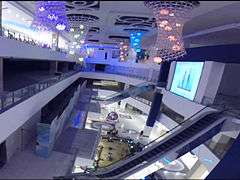
Today Isfahan, the third largest city in Iran, produces fine carpets, textiles, steel, handicrafts, specific sweet and traditional delicious foods. Isfahan also has nuclear experimental reactors as well as facilities for producing nuclear fuel (UCF). Isfahan has one of the largest steel-producing facilities in the entire region, as well as facilities for producing special alloys.
The city has an international airport and is in the final stages of constructing its first Metro line.
Over 2000 companies work in the area using Isfahan's economic, cultural, and social potentials. Isfahan contains a major oil refinery and a large airforce base. HESA, Iran's most advanced aircraft manufacturing plant (where the IR.AN-140 aircraft is made), is located nearby.[13][14] Isfahan is also becoming an attraction for international investments,[15] like investments in Isfahan City Center,[16] which is the largest shopping mall in Iran and the largest shopping mall with a museum in the world and has the largest indoor amusement park in the middle-east.[17]
Isfahan hosted the International Physics Olympiad in 2007.
Geography and climate
The city is located in the lush plain of the Zayanderud River, at the foothills of the Zagros mountain range. The nearest mountain is Mount Soffeh (Kuh-e Soffeh) which is situated just south of Isfahan. No geological obstacles exist within 90 kilometres (56 miles) north of Isfahan, allowing cool northern winds to blow from this direction. Situated at 1,590 metres (5,217 ft) above sea level on the eastern side of the Zagros Mountains, Isfahan has an arid climate (Köppen BSk). Despite its altitude, Isfahan remains hot during the summer with maxima typically around 35 °C (95 °F). However, with low humidity and moderate temperatures at night, the climate can be very pleasant. During the winter, days are mild while nights can be very cold. Snow has occurred at least once every winter except 1986/1987 and 1989/1990.[18][19]
| Climate data for Isfahan (1961–1990, extremes 1951–2010) | |||||||||||||
|---|---|---|---|---|---|---|---|---|---|---|---|---|---|
| Month | Jan | Feb | Mar | Apr | May | Jun | Jul | Aug | Sep | Oct | Nov | Dec | Year |
| Record high °C (°F) | 20.4 (68.7) |
23.4 (74.1) |
29.0 (84.2) |
32.0 (89.6) |
37.6 (99.7) |
41.0 (105.8) |
43.0 (109.4) |
42.0 (107.6) |
39.0 (102.2) |
33.2 (91.8) |
26.8 (80.2) |
21.2 (70.2) |
43.0 (109.4) |
| Average high °C (°F) | 8.8 (47.8) |
11.9 (53.4) |
16.8 (62.2) |
22.0 (71.6) |
28.0 (82.4) |
34.1 (93.4) |
36.4 (97.5) |
35.1 (95.2) |
31.2 (88.2) |
24.4 (75.9) |
16.9 (62.4) |
10.8 (51.4) |
23.0 (73.4) |
| Daily mean °C (°F) | 2.7 (36.9) |
5.5 (41.9) |
10.4 (50.7) |
15.7 (60.3) |
21.3 (70.3) |
27.1 (80.8) |
29.4 (84.9) |
27.9 (82.2) |
23.5 (74.3) |
16.9 (62.4) |
9.9 (49.8) |
4.4 (39.9) |
16.2 (61.2) |
| Average low °C (°F) | −2.4 (27.7) |
−0.2 (31.6) |
4.5 (40.1) |
9.4 (48.9) |
14.2 (57.6) |
19.1 (66.4) |
21.5 (70.7) |
19.8 (67.6) |
15.1 (59.2) |
9.3 (48.7) |
3.6 (38.5) |
−0.9 (30.4) |
9.4 (48.9) |
| Record low °C (°F) | −19.4 (−2.9) |
−12.2 (10) |
−8 (18) |
−4 (25) |
4.5 (40.1) |
10.0 (50) |
13.0 (55.4) |
11.0 (51.8) |
5.0 (41) |
0.0 (32) |
−8 (18) |
−13 (9) |
−19.4 (−2.9) |
| Average precipitation mm (inches) | 17.1 (0.673) |
14.1 (0.555) |
18.2 (0.717) |
19.2 (0.756) |
8.8 (0.346) |
0.6 (0.024) |
0.7 (0.028) |
0.2 (0.008) |
0.0 (0) |
4.1 (0.161) |
9.9 (0.39) |
19.6 (0.772) |
112.5 (4.429) |
| Average precipitation days (≥ 1.0 mm) | 4.0 | 2.9 | 3.8 | 3.5 | 2.0 | 0.2 | 0.3 | 0.1 | 0.0 | 0.8 | 2.2 | 3.7 | 23.5 |
| Average snowy days | 3.2 | 1.7 | 0.7 | 0.1 | 0.0 | 0.0 | 0.0 | 0.0 | 0.0 | 0.0 | 0.2 | 1.9 | 7.8 |
| Average relative humidity (%) | 60 | 51 | 43 | 39 | 33 | 23 | 23 | 24 | 26 | 36 | 48 | 57 | 39 |
| Mean monthly sunshine hours | 205.3 | 213.3 | 242.1 | 244.5 | 301.3 | 345.4 | 347.6 | 331.2 | 311.6 | 276.5 | 226.1 | 207.6 | 3,252.5 |
| Source #1: NOAA[20] | |||||||||||||
| Source #2: Iran Meteorological Organization (records)[21][22] | |||||||||||||
| Esfahan, Iran | ||||||||||||||||||||||||||||||||||||||||||||||||||||||||||||
|---|---|---|---|---|---|---|---|---|---|---|---|---|---|---|---|---|---|---|---|---|---|---|---|---|---|---|---|---|---|---|---|---|---|---|---|---|---|---|---|---|---|---|---|---|---|---|---|---|---|---|---|---|---|---|---|---|---|---|---|---|
| Climate chart (explanation) | ||||||||||||||||||||||||||||||||||||||||||||||||||||||||||||
| ||||||||||||||||||||||||||||||||||||||||||||||||||||||||||||
| ||||||||||||||||||||||||||||||||||||||||||||||||||||||||||||
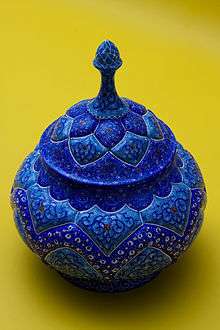
Main sights





Bazaars
- Shahi Bazaar – 17th century
- Qeysarie Bazaar - 17th century
Bridges
The Zayande River starts in the Zagros Mountains, flows from west to east through the heart of Isfahan, and dries up in the Gavkhooni wetland.
The bridges over the river include some of the finest architecture in Isfahan. The oldest bridge is the Shahrestan bridge or "Pol-e Shahrestan", whose foundations was built by the Sasanian Empire (3rd-7th century Sassanid era) and has been repaired during the Seljuk period.پل شهرستان. Further upstream is the "Pol-e Khaju", which was built by Shah Abbas II in 1650. It is 123 metres long with 24 arches, and also serves as a sluice gate.
The next bridge is the "Pol-e Chubi". It was originally built as an aqueduct to supply the palace gardens on the north bank of the river. Further upstream again is the Si-o-Seh Pol or bridge of 33 arches. Built during the rule of Shah Abbas the Great, it linked Isfahan with the Armenian suburb of New Julfa. It is by far the longest bridge in Isfahan at 295 m (967.85 ft).
Other bridges include:
- Marnan Bridge
- Pol-e-Joui or Choobi (Joui bridge) – 1665
- Pol-e Khaju (Khaju Bridge) – 1650
- Pol-e Shahrestan (The Shahrestan bridge)
- Si-o-Seh Pol (The Bridge of 33 Arches) – 1602
Churches and cathedrals
- Bedkhem Church – 1627
- St. Georg Church – 17th century
- St. Jakob Church _ 1607
- St. Mary Church – 17th century
- Vank Cathedral – 1664
Emamzadehs
- Emamzadeh Ahmad
- Emamzadeh Esmaeil, Isfahan
- Emamzadeh Haroun-e-Velayat – 16th century
- Emamzadeh Jafar
- Emamzadeh Shah Zeyd
Gardens and parks
Houses
- Alam's House
- Amin's House
- Malek Vineyard
- Qazvinis' House – 19th century
- Sheykh ol-Eslam's House
Mausoleums and tombs
- Al-Rashid Mausoleum – 12th century
- Baba Ghassem Mausoleum – 14th century
- Mausoleum of Safavid Princes
- Nizam al-Mulk Tomb – 11th century
- Saeb Mausoleum
- Shahshahan mausoleum – 15th century
- Soltan Bakht Agha Mausoleum – 14th century
Minarets
- Ali minaret – 11th century
- Bagh-e-Ghoushkhane minaret – 14th century
- Chehel Dokhtaran minaret – 12 century
- Dardasht minarets – 14th century
- Darozziafe minarets – 14th century
- Menar Jonban – 14th century
- Sarban minaret
Mosques
- Agha Nour mosque – 16th century
- Hakim Mosque
- Ilchi mosque
- Jameh Mosque[24]
- Jarchi mosque – 1610
- Lonban mosque
- Maghsoudbeyk mosque – 1601
- Mohammad Jafar Abadei mosque – 1878
- Rahim Khan mosque – 19th century
- Roknolmolk mosque
- Seyyed mosque – 19th century
- Shah Mosque – 1629
- Sheikh Lotf Allah Mosque – 1618
Museums
- Contemporary Arts Museum Isfahan
- Isfahan City Center Museum
- Museum of Decorative Arts
- Natural History Museum of Isfahan – 15th century
Schools (madresse)
- Chahar Bagh School – early 17th century
- Harati
- Kassegaran school – 1694
- Madreseye Khajoo
- Nimavar school – 1691
- Sadr school – 19th century
Palaces and caravanserais
- Ali Qapu (The Royal Palace) – early 17th century
- Chehel Sotoun (The Palace of Forty Columns) – 1647
- Hasht-Behesht (The Palace of Eight Paradises) – 1669
- Shah Caravanserai
- Talar Ashraf (The Palace of Ashraf) – 1650
Squares and streets
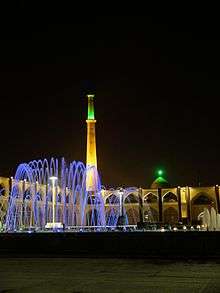
- Chaharbagh Boulevard – 1596
- Chaharbagh-e-khajou Boulevard
- Meydan Kohne (Old Square)
- Naqsh-e Jahan Square also known as "Shah Square" or "Imam Square" – 1602
Synagogues
- Kenisa-ye Bozorg (Mirakhor's kenisa)
- Kenisa-ye Molla Rabbi
- Kenisa-ye Sang-bast
- Mullah Jacob Synagogue
- Mullah Neissan Synagogue
- Kenisa-ye Keter David
Tourist attractions
Isfahan is an important historical center for different groups of tourists in the domestic and international world. The central historical area in Isfahan is called Seeosepol (the name of a famous bridge).[25][26]
Other sites
- Atashgah – a Zoroastrian fire temple
- The Bathhouse of Bahāʾ al-dīn al-ʿĀmilī
- Isfahan City Center
- Jarchi hammam
- New Julfa (The Armenian Quarter) – 1606
- Pigeon Towers[27] – 17th century
- Takht-e Foulad
Transportation
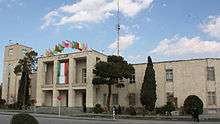
Airport
Isfahan is served by the Isfahan International Airport which handles domestic flights to Iranian cities and international flights. Turkish Airlines operates four weekly flights to Istanbul, and there are a number of flights to Arabic countries such as UAE, Iraq and Kuwait every day.
Metro and inter-city public transportation
Isfahan Metro is under construction and will include two lines with 43 km (27 mi) length. Line 1 was planned to be finished by end of 2010 with 21 km (13 mi) length and 20 stations. The first phase of that so far was opened on 15 October 2015 with 11 km (7 mi) length and 10 stations.
Rail
Isfahan is connected to three major rail lines: Isfahan–Tehran, Isfahan–Shiraz (recently opened), Isfahan–Yazd and via this recent one to Bandar Abbas and Zahedan.
Road transport
Isfahan's internal highway network is currently under heavy expansion which began during the last decade. Its lengthy construction is due to concerns of possible destruction of valuable historical buildings. Outside the city, Isfahan is connected by modern highways to Tehran which spans a distance of nearly 400 km (248.55 mi) to North and to Shiraz at about 200 km (124.27 mi) to the south. The highways also service satellite cities surrounding the metropolitan area.[28]
-

Traffic in Isfahan
-
Traffic police
-

Charbagh Street in Spring
-

Domestic flights hall of Isfahan International Airport
-

Isfahan Metro wagons
Culture
.jpg)

Rug manufacture
Isfahan has long been one of the centers for production of the famous Persian rug. Weaving in Isfahan flourished in the Safavid era. But when the Afghans invaded Iran, ending the Safavid dynasty, the craft became stagnant.
Food
- Isfahan is famous for its beryouni. This dish is made of baked mutton and lungs that are minced and then cooked in a special small pan over open fire with a pinch of cinnamon. Beryouni is generally eaten with a certain type of bread, taftoon, although it can also be served with other breads.
- Fesenjān is a casserole type dish with a sweet and tart sauce containing the two base ingredients, pomegranate molasses and ground walnuts cooked with chicken, duck, lamb or beef, and served with rice.
- Gaz – the name given to Persian nougat using the sap collected from angebin, a plant from the tamarisk family found only on the outskirts of Isfahan. It is mixed with various ingredients including rosewater, pistachio and almond kernels and saffron.
- Khoresh-e mast (yoghurt stew) is a traditional dish in Isfahan. Unlike other stews despite its name, it is not served as a main dish and with rice; since it is more of a sweet pudding it is usually served as a side dish or dessert. The dish is made with yogurt, lamb/mutton or chicken, saffron, sugar and orange zest. Iranians either put the orange zest in water for one week or longer or boil them for few minutes so the orange peels become sweet and ready for use. People in Iran make a lot of delicate dishes and jam with fruit rinds. This dish often accompanies celebrations and weddings.
- Pulaki is the name given to a type of Isfahani candy which is formed into thin circles like coins and served with tea or other warm drinks.
Notable people

- Music
- Jalal Taj Eesfahani (1903-1981), musician, singer and vocalist
- Alireza Eftekhari (1956– ), singer
- Leila Forouhar, pop singer
- Freydoon Rassouli, artist and founder of the Fusionart movement
- Jalil Shahnaz (1921–2013), soloist of tar, a traditional Persian instrument
- Hassan Shamaizadeh, songwriter and singer
- Film
- Rasul Sadr Ameli (1953–), director
- Reza Arhamsadr (1924–2008), actor
- Homayoun Ershadi (1947–), Hollywood actor and architect
- Soraya Esfandiary-Bakhtiari (1956–2001), former princess of Iran and actress
- Asghar Farhadi (1972– ), Oscar-winning director
- Bahman Farmanara (1942–), director
- Jahangir Forouhar (1916–1997), actor and father of Leila Forouhar (Iranian singer)
- Mohamad Ali Keshvarz (1930-), actor
- Kiumars Poorahmad (1949–), director
- Soroush Sehat, actor and director
- Painters
- Mahmoud Farshchian (1930–), miniaturist
- Freydoon Rassouli, American painter born and raised in Isfahan
- Bogdan Saltanov (1630s–1703), Russian icon painter of Isfahanian Armenian origin
- Political figures
- Ayatollah Mohammad Beheshti (1928–1981), cleric, Chairman of the Council of Revolution of Iran
- Mohammad-Ali Foroughi, a politician and Prime Minister of Iran in the World War II era
- Hossein Fatemi, PhD (1919–1954), politician; foreign minister in Mohamed Mossadegh's cabinet
- Ahmad Amir-Ahmadi (1906–1965), military leader and cabinet minister
- Hossein Kharrazi, chief of the army in the Iran–Iraq war
- Mohsen Nourbakhsh (1948–2003), economist, Governor of the Central Bank of Iran
- Nusrat Bhutto, Chairman of Pakistan Peoples Party from 1979–1983; wife of Zulfikar Ali Bhutto; mother of Benazir Bhutto
- Dariush Forouhar (August 1928 – November 1998), a founder and leader of the Hezb-e Mellat-e Iran (Nation of Iran Party)
- Mohammad Javad Zarif (January 1960 –), Minister of Foreign Affairs and former Ambassador of Iran to the United Nations
- Religious figures
- Lady Amin (Banou Amin) (1886–1983), Iran's most outstanding female jurisprudent, theologian and great Muslim mystic (‘arif), a Lady Mujtahideh
- Amina Begum Bint al-Majlisi was a female Safavid mujtahideh
- Allamah al-Majlisi (1616–1698), Safavid cleric, Sheikh ul-Islam in Isfahan
- Ayatollah Mohammad Beheshti (1928–1981), cleric, Chairman of the Council of Revolution of Iran
- Salman the Persian
- Sportspeople
- Abdolali Changiz, football star of Esteghlal FC in the 1970s
- Mansour Ebrahimzadeh, former player for Sepahan FC, former head coach of Zobahan
- Ghasem Haddadifar, captain of Zobahan
- Ehsan Hajsafi, player for the Sepahan and FSV Frankfurt
- Arsalan Kazemi, forward for the Oregon Ducks men's basketball team and the Iran national basketball team
- Rasoul Korbekandi, goalkeeper of the Iranian National Team
- Moharram Navidkia, captain of Sepahan
- Mohsen Sadeghzadeh, former captain of Iran national basketball team and Zobahan
- Mohammad Talaei, world champion wrestler
- Mahmoud Yavari (1939-), former football player, and later coach for Iranian National Team
- Writers and poets
- Mohammad-Ali Jamālzādeh Esfahani (1892–1997), author
- Hatef Esfehani, Persian Moral poet in the Afsharid Era
- Kamal ed-Din Esmail (late 12th century - early 13th century)
- Houshang Golshiri (1938–2000), writer and editor
- Hamid Mosadegh (1939–1998), poet and lawyer
- Mirza Abbas Khan Sheida (1880–1949), poet and publisher
- Saib Tabrizi
- Others
- David II of Kakheti, king of Kakheti in eastern Georgia from 1709 to 1722
- Constantine II of Kakheti, king of Kakheti in eastern Georgia from 1722 to 1732
- Nasser David Khalili (1945–), property developer, art collector, and philanthropist
- Arthur Pope (1881–1969), American archaeologist, buried near Khaju Bridge
Education

Aside from the seminaries and religious schools, the major universities of the Esfahan metropolitan area are:
- Universities
- High schools
- Adab High School
- Farzanegan e Amin High School
- Harati High School
- Imam Mohammad Bagher Education Complex
- Imam Sadegh Education Complex
- Mahboobeh Danesh (Navaie)
- Pooya High School
- Saadi High School
- Sa'eb Education Complex
- Salamat High School
- Saremiyh High School
- Shahid Ejei High School
There are also more than 50 technical and vocational training centers under the administration of Esfahan TVTO which provide non-formal training programs freely throughout the province.[29]
Sports
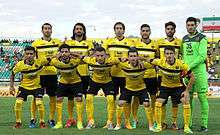

Isfahan is the host of many national and international sport events, therefore enjoying sport facilities such as Naghsh-e-Jahan Stadium with 50,000 capacity. A second phase is under development to increase its capacity to 75,000 spectators.
Isfahan has an important derby, the Naqsh e jahan derby. This competition is one of the most popular annual football events in Iran between Sepahan Isfahan and Zob Ahan Isfahan.
Both Zob Ahan and Sepahan are the only Iranian clubs to reach the final of the new AFC Champions League.
Isfahan has three association football clubs that play professionally. These are:
Giti Pasand also has a futsal team, Giti Pasand FSC, one of the best teams in Asia and Iran. They won the AFC Futsal Club Championship in 2012 and were runners-up in 2013.
Twin towns – sister cities

Isfahan is twinned with:
See also
References
- Notes
- ↑ http://www.daftlogic.com/downloads/kml/10102015-9mzrdauu.kml
- 1 2 http://www.citypopulation.de/php/iran-esfahan.php
- ↑ 2006 Census Results and Mashhad(Statistical Center of Iran, Excel file, in Persian.)
- ↑ "Isfahan Is Half The World", Saudi Aramco World, Volume 13, Nr. 1, January 1962
- ↑ "Isfahan, Pre-Islamic-Period". Encyclopædia Iranica. 15 December 2006. Retrieved 31 December 2015.
- ↑ Strazny, P. (2005). Encyclopedia of linguistics (p. 325). New York: Fitzroy Dearborn.
- ↑ Historical Geography, Isfahan, http://www.iranicaonline.org//
- ↑ Sacred Precincts: The Religious Architecture of Non-Muslim Communities Across the Islamic World, Gharipour Mohammad, BRILL, Nov 14, 2014 page 179.
- ↑ http://archnet.org/library/places/one-place.jsp?place_id=1752&order_by=title&showdescription=1
- ↑ History of Isfahan, Isfahan http://www.britannica.com//
- 1 2 3 4 5 6 7 Isfahan-Safavid Period VII
- ↑ Assari, A., Mahesh, T., Emtehani, M., & Assari, E. (2011). Comparative sustainability of bazaar in Iranian traditional cities: Case studies in Isfahan and Tabriz. International Journal on Technical and Physical Problems of Engineering (IJTPE)(9), 18-24.
- ↑ Hesaco.com (from the HESA official company website)
- ↑ [
- ↑
- ↑ [ ]
- ↑ List of largest shopping malls in the world
- ↑ "Snowy days for Esfahan". Irimo.ir. Retrieved 2012-04-23.
- ↑ assari, ali; T.M. Mahesh (August 2011). "Demographic comparative in heritage texture of Isfahan city" (PDF). Journal of Geography and Regional Planning. ISSN 2070-1845 2011 Academic Journals 4 (8): 463–470. Retrieved 6 January 2013.
- ↑ "Esfahan Climate Normals 1961-1990". National Oceanic and Atmospheric Administration. Retrieved April 8, 2015.
- ↑ "Highest record temperature in Esfahan by Month 1951–2010". Iran Meteorological Organization. Retrieved April 8, 2015.
- ↑ "Lowest record temperature in Esfahan by Month 1951–2010". Iran Meteorological Organization. Retrieved April 8, 2015.
- ↑ "Weather Information for Esfahan". World Weather Information Service.
- ↑ "Isfahan Jame(Congregative) mosque – BackPack". Fz-az.fotopages.com. Retrieved 2009-07-26.
- ↑ "Seifolddini-Faranak; M. S. Fard; Hosseini Ali" (PDF). thescipub.com.
- ↑ Assari, Ali; T.M. Mahesh (January 2012). "Conservation of historic urban core in traditional Islamic culture: case study of Isfahan city" (PDF). Indian Journal of Science and Technology 5 (1): 1970–1976. Retrieved 7 January 2013.
- ↑ "Castles of the Fields". Saudi Aramco World. Retrieved 2012-09-11.
- ↑ Assari, Ali; Erfan Assari (2012). "Urban spirit and heritage conservation problems: case study Isfahan city in Iran" (PDF). Journal of American Science 8 (1): 203–209. Retrieved 7 January 2013.
- ↑ "Isfahan Technical and Vocational Training Organization". Web.archive.org. 8 October 2007. Archived from the original on 8 October 2007. Retrieved 2012-04-23.
- ↑ "Isfahan, Beirut named sister cities". MNA. Retrieved 2007-05-02.
- ↑ "Barcelona internacional – Ciutats agermanades" (in Catalan). 2006–2009 Ajuntament de Barcelona. Retrieved 2009-07-13. External link in
|publisher=(help) - ↑ "Sister Cities of Istanbul". Retrieved 2009-07-01.
- ↑ Erdem, Selim Efe (1 July 2009). "İstanbul'a 49 kardeş" (in Turkish). Radikal. Retrieved 2009-07-26.
49 sister cities in 2003
- ↑ "Sisterhoods". Isfahan Islamic Council. 2005. Archived from the original on 12 October 2007. Retrieved 2007-12-04.
- ↑ Mansab Dogar, , "Daily Times" , October 15, 2008
- ↑ "Saint Petersburg in figures – International and Interregional Ties". Saint Petersburg City Government. Retrieved 2008-07-14.
- ↑ "Yerevan – Twin Towns & Sister Cities". Yerevan Municipality Official Website. 2005—2013 http://www.yerevan.am. Retrieved 2013-11-04. External link in
|publisher=(help) - ↑ ԵՐԵՎԱՆԻ ՔԱՂԱՔԱՊԵՏԱՐԱՆՊԱՇՏՈՆԱԿԱՆ ԿԱՅՔ [Yerevan expanding its international relations] (in Armenian). . Archived from the original on 12 May 2013. Retrieved 2013-08-05. External link in
|publisher=(help)
External links
| Wikimedia Commons has media related to Isfahan. |
![]() Isfahan travel guide from Wikivoyage
Isfahan travel guide from Wikivoyage
- Isfahan official website
- Isfahan Metro
- 360-degree panorama gallery of Isfahan
- Isfahan Geometry on a Human Scale - a documentary film directed by Manouchehr Tayyab (30 min)
| Preceded by Rey |
Capital of Seljuq Empire (Persia) 1051–1118 |
Succeeded by Hamadan (Western capital) Merv (Eastern capital) |
| Preceded by Qazvin |
Capital of Iran (Persia) 1598–1736 |
Succeeded by Mashhad |
| Preceded by Qazvin |
Capital of Safavid dynasty 1598–1722 |
Succeeded by - |
| ||||||||||||||||||||||||||||||||||||||||||||||||||||||||||||||||||||||||||||||||||||||||||||||||||||||||||||||||||||
| ||||||||||||||||||||||||||||||||||
|


